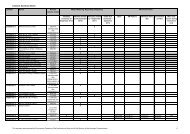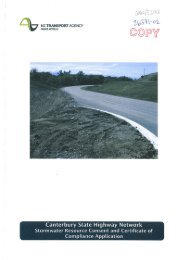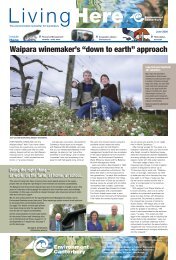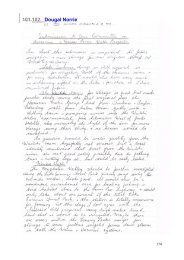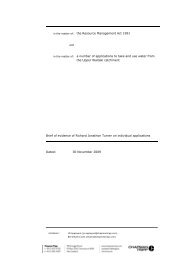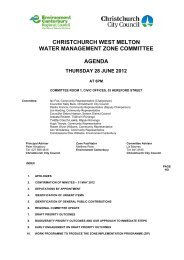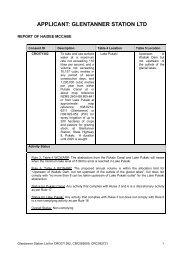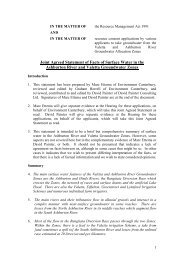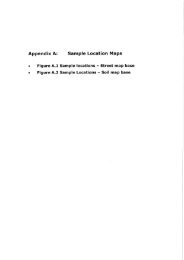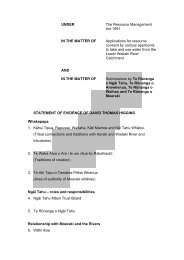Sedimentation in the Upper Lyttelton Harbour - Environment ...
Sedimentation in the Upper Lyttelton Harbour - Environment ...
Sedimentation in the Upper Lyttelton Harbour - Environment ...
You also want an ePaper? Increase the reach of your titles
YUMPU automatically turns print PDFs into web optimized ePapers that Google loves.
Curtis (1985) suggested that <strong>the</strong> differences <strong>in</strong> tidal current velocities and durations<br />
between <strong>the</strong> two sides of <strong>the</strong> harbour gave rise to transverse, cross-harbour currents<br />
(Figure 2). Fur<strong>the</strong>r, he postulated that <strong>the</strong> <strong>in</strong>teraction of <strong>the</strong>se currents with harbour<br />
topography often led to <strong>the</strong> development of a large clockwise gyre <strong>in</strong> <strong>the</strong> central to<br />
lower harbour on <strong>the</strong> flood tide and a comparable anti-clockwise gyre on <strong>the</strong> ebb<br />
tide. Gyre development was not, however, observed on every tidal cycle and, when<br />
present, <strong>the</strong> gyre operated for 50% of any given tidal cycle. Curtis (1985)<br />
suggested that <strong>the</strong> development of <strong>the</strong> gyre was a function of tidal characteristics,<br />
<strong>in</strong>clud<strong>in</strong>g amplitude and duration, and external <strong>in</strong>fluences, <strong>in</strong>clud<strong>in</strong>g wave and w<strong>in</strong>d<strong>in</strong>duced<br />
current conditions.<br />
Kirk (1992) observed that gyres are frequently visible <strong>in</strong> harbour waters from <strong>the</strong> air,<br />
whilst Spigel (1993a, 1993b), us<strong>in</strong>g dye trac<strong>in</strong>g experiments, confirmed <strong>the</strong> existence<br />
of transverse flows with<strong>in</strong> <strong>the</strong> central and lower harbour. Dye released from <strong>the</strong><br />
vic<strong>in</strong>ity of <strong>the</strong> port breakwater dispersed across <strong>the</strong> harbour with<strong>in</strong> two tidal cycles<br />
and, later, along <strong>the</strong> length of <strong>the</strong> harbour <strong>in</strong>to to <strong>the</strong> entrance of Charteris Bay <strong>in</strong> <strong>the</strong><br />
south, and Cass and Rapaki Bays <strong>in</strong> <strong>the</strong> north.<br />
Sediment Sources<br />
<strong>Sedimentation</strong> with<strong>in</strong> <strong>Lyttelton</strong> <strong>Harbour</strong> may comprise material sourced externally,<br />
from catchment hill slopes or Pegasus Bay, or from sources with<strong>in</strong> <strong>the</strong> harbour,<br />
<strong>in</strong>clud<strong>in</strong>g <strong>the</strong> re-circulation of dredge spoil and erosion of thick bed deposits.<br />
Catchment Erosion<br />
On average, an estimated 44i300itia -1 of loess and loess colluvium is eroded from<br />
<strong>the</strong> <strong>Lyttelton</strong> <strong>Harbour</strong> catchment (Curtis 1985) most of which is deposited with<strong>in</strong> <strong>the</strong><br />
mar<strong>in</strong>e environment of <strong>the</strong> <strong>in</strong>let (Figure 3). These deposits play a major role <strong>in</strong><br />
ma<strong>in</strong>ta<strong>in</strong><strong>in</strong>g high levels of turbidity with<strong>in</strong> <strong>the</strong> <strong>in</strong>let as <strong>the</strong>y are readily suspended by<br />
waves and tidal currents and rema<strong>in</strong> <strong>in</strong> suspension for prolonged periods.<br />
Catchment erosion rates are an order of magnitude greater <strong>in</strong> <strong>the</strong> upper harbour<br />
between Cass Bay and Head of <strong>the</strong> Bay, than along <strong>the</strong> hill slopes adjacent to<br />
central and lower areas of <strong>the</strong> harbour. This erosion is <strong>the</strong> most important source of<br />
external sediment for <strong>the</strong> upper harbour. Fluvial <strong>in</strong>puts are concentrated <strong>in</strong> this area<br />
and s<strong>in</strong>k to <strong>the</strong> bottom of <strong>the</strong> water column where <strong>the</strong>ir sediment load settles out<br />
rapidly.<br />
Pegasus Bay<br />
The volume of sediment enter<strong>in</strong>g <strong>the</strong> harbour from Pegasus Bay is unknown<br />
(Figurei3). The lower harbour and dredged channel, however, likely operate as<br />
efficient s<strong>in</strong>ks for such material, prevent<strong>in</strong>g any from be<strong>in</strong>g transported <strong>in</strong>to <strong>the</strong> upper<br />
harbour.<br />
8



